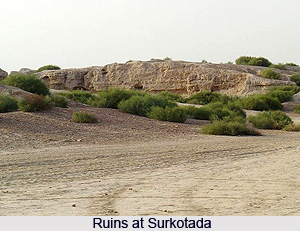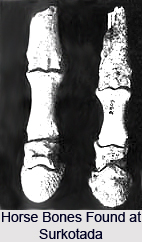 Surkotada, situated at a distance of 160 kilometres towards north east of Bhuj at Kutch district of Gujarat, is an archaeological site where relics of Indus Valley Civilization have been found. It is a small fortified region stretching across an area of 1.4 hectares. The site houses an old mound enclosed by undulating ground having small sandstone hills. The complete region exhibits a reddish brown colour owing to the red laterite soil that covers the hills. Surkotada has sparse vegetation but grows small Pilu and Babul trees, Cactus and thorny shrubs for which the place appears adorned with green patches over the red land. Shri Jagat Pati Joshi of Archaeological Survey of India is accredited with the discovery of the mounds. On the eastern side of the site the mounds have a lower height as compared to that in the western side. In ancient times in the north eastern part of the site a 750 metres wide river used to flow which merges with the Little Rann. It is believed that the river had once served as a major reason of the thriving settlements here. The river is presently in the form of a small stream.
Surkotada, situated at a distance of 160 kilometres towards north east of Bhuj at Kutch district of Gujarat, is an archaeological site where relics of Indus Valley Civilization have been found. It is a small fortified region stretching across an area of 1.4 hectares. The site houses an old mound enclosed by undulating ground having small sandstone hills. The complete region exhibits a reddish brown colour owing to the red laterite soil that covers the hills. Surkotada has sparse vegetation but grows small Pilu and Babul trees, Cactus and thorny shrubs for which the place appears adorned with green patches over the red land. Shri Jagat Pati Joshi of Archaeological Survey of India is accredited with the discovery of the mounds. On the eastern side of the site the mounds have a lower height as compared to that in the western side. In ancient times in the north eastern part of the site a 750 metres wide river used to flow which merges with the Little Rann. It is believed that the river had once served as a major reason of the thriving settlements here. The river is presently in the form of a small stream.
Chronological Phases at Surkotada
The evidences found at Surkotada mostly dates back to an era which is much later than other Harappan or Indus Valley Civilization. However the occupational dates found at Surkotada are well in conformity with that of Lothal and Kalibangan. This establishes the fact that the Harappans had settled in Surkotada during the late phases of their civilization. The gates found at the site also exhibit uniqueness as compared to the general Harappan trends. This site had evidences of occupation for about a period of 400 years without any break. This is categorized into three phases on the basis of building activities. Researches also support the fact that feudal system of administration was prominent in the civilization and it possibly served as a garrison town or regional capital.
 Period IA of Surkotada
Period IA of Surkotada
Period IA of Surkotada belongs to 2100 BC to 1950 BC. The earliest inhabitants of this site had built a citadel structure with mud brick and a fortification of mud lump having a rubble veneer of five to eight courses on a raised rammed yellow earth platform. The residential area was also constructed with a fortification. There were two entrances in the citadel, on eastern and southern side which led to the residential area. Evidences suggest that proper sanitary and drainage system were present during this phase of settlement.
Period IB of Surkotada
Period IB of Surkotada continues from 1950 BC to 1800 BC and exhibits a prominent continuity with Period IA. Arrival of new techniques marks the beginning of this phase which includes new form of instruments and pottery. The citadel structure was retained but a mud brick reinforcement was added inside the fortification wall. The end of this phase occurred due to an extensive conflagration which is evident by a thick layer of ash.
Period IC of Surkotada
Period IC of Surkotada dates from 1800 BC to 1700 BC which started just after the conflagration, when a new group of people arrived at the place and settled down. The settlement pattern of the predecessors was followed by the new group and thus they built a citadel along with a residential complex at the same lines structured with dressed stones and rubble.
Animal Remains at Surkotada
One of the intriguing features of Surkotada is formed by the bone remains of Horse belonging to 2000 BCE. Apart from these remains of Mongooses have also been discovered which indicates their use as a protection against snakes. Skeletal remains of wolves, camel, sheep and elephants have also been revealed at Surkotada.



















